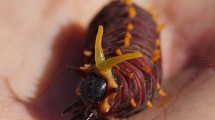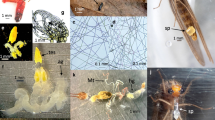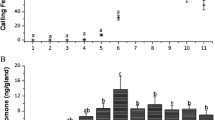Abstract
Most oribatid mites are well known for their exocrine oil gland secretions, from which more than a hundred different chemical components (hydrocarbons, terpenes, aromatics and alkaloids) have been described. The biological functions of these secretions have remained enigmatic for most species, but alarm-pheromonal and allomonal functions have been hypothesized, and demonstrated in some cases. Here, we tested different experimental stimuli to induce the release of defensive secretions in the model oribatid mite Archegozetes longisetosus Aoki. Whereas various mechanical stimuli did not result in a reproducible and complete expulsion of oil gland secretions, repeated treatments with hexane led to complete discharge. Life history parameters such as survival, development and reproduction were not influenced by the hexane treatment. Repeated hexane treatments also resulted in a complete depletion of oil glands in Euphthiracarus cribrarius Berlese.



Similar content being viewed by others
References
Alberti G, Heethoff M, Norton RA, Schmelzle S, Seniczak A, Seniczak S (2011) Fine structure of the gnathosoma of Archegozetes longisetosus Aoki (Acari: Oribatida, Trhypochthoniidae). J Morph 272:1025–1079. doi:10.1002/jmor.10971
Bergmann P, Laumann M, Cloetens P, Heethoff M (2008) Morphology of the internal reproductive organs of Archegozetes longisetosus Aoki (Acari, Oribatida). Soil Org 80:171–195
Blum MS (1996) Semiochemical parsimony in the Arthropoda. Ann Rev Entomol 41:353–374. doi:10.1146/annurev.en.41.010196.002033
Eisner T (2003) For love of insects. Harvard University Press, Cambridge
Eisner T, Rossini C, González A, Eisner M (2004) Chemical defense of an opilionid (Acanthopachylus aculeatus). J Exp Biol 207:1313–1321. doi:10.1242/jeb.00849
Eisner T, Eisner M, Siegler M (2005) Secret weapons. Harvard University Press, Cambridge
Heethoff M, Koerner L (2007) Small but powerful—the oribatid mite Archegozetes longisetosus Aoki (Acari, Oribatida) produces disproportionately high forces. J Exp Biol 210:3036–3042. doi:10.1242/jeb.008276
Heethoff M, Raspotnig G (2011) Is 7-hydroxyphthalide a natural compound of oil gland secretions?—evidence from Archegozetes longisetosus (Acari, Oribatida). Acarologia 51:229–236. doi:10.1051/acarologia/20112004
Heethoff M, Raspotnig G (2012) Expanding the ‘enemy-free space’ for oribatid mites: evidence for chemical defense of juvenile Archegozetes longisetosus against the rove beetle Stenus juno. Exp Appl Acarol 56:93–97. doi:10.1007/s10493-011-9501-1
Heethoff M, Laumann M, Bergmann P (2007) Adding to the reproductive biology of the parthenogenetic oribatid mite, Archegozetes longisetosus (Acari, Oribatida, Trhypochthoniidae). Turk J Zool 31:151–159
Heethoff M, Norton RA, Scheu S, Maraun M (2009) Parthenogenesis in oribatid mites (Acari, Oribatida): evolution without sex. In: Schön I, Martens K, van Dijk P (eds) Lost sex: the evolutionary biology of parthenogenesis. Springer, Dordrecht, pp 241–57. doi:10.1007/978-90-481-2770-2_12
Heethoff M, Koerner L, Norton RA, Raspotnig G (2011a) Tasty but protected—first evidence of chemical defense in oribatid mites. J Chem Ecol 37:1037–1043. doi:10.1007/s10886-011-0009-2
Heethoff M, Laumann M, Weigmann G, Raspotnig G (2011b) Integrative taxonomy: combining morphological, molecular and chemical data for species delineation in the parthenogenetic Trhypochthonius tectorum complex (Acari, Oribatida, Trhypochthoniidae). Front Zool 8:2. doi:10.1186/1742-9994-8-2
Laumann M, Bergmann P, Norton RA, Heethoff M (2010) First cleavages, preblastula and blastula in the parthenogenetic mite Archegozetes longisetosus (Acari, Oribatida) indicate holoblastic rather than superficial cleavage. Arth Struct Dev 39:276–286. doi:10.1016/j.asd.2010.02.003
Pomini AM, Machado G, Pinto-da-Rocha R, Macias-Ordonez R, Marsaioli AJ (2010) Lines of defense in the harvestman Hoplobunus mexicanus (Arachnida: Opiliones): aposematism, stridulation, thanatosis, and irritant chemicals. Biochem Syst Ecol 38:300–308. doi:10.1016/j.bse.2010.03.003
Raspotnig G (2006) Chemical alarm and defence in the oribatid mite Collohmannia gigantea (Acari: Oribatida). Exp Appl Acarol 39:177–194. doi:10.1007/s10493-006-9015-4
Raspotnig G, Norton RA, Heethoff M (2011) Oribatid mites and skin alkaloids in poison frogs. Biol Lett 7:555–556. doi:10.1098/rsbl.2010.1113
Sakata T, Norton RA (2001) Opisthonotal gland chemistry of early-derivative oribatid mites (Acari) and its relevance to systematic relationships of Astigmata. Int J Acarol 27:281–292
Sanders FH, Norton RA (2004) Anatomy and function of the ptychoid defensive mechanism in the mite Euphthiradarus cooki (Acari: Oribatida). J Morphol 259:119–154
Shimano S, Sakata T, Mizutani Y, Kuwahara Y, Aoki J (2002) Geranial: the alarm pheromone in the nymphal stage of the oribatid mite, Nothrus palustris. J Chem Ecol 28:1831–1837
Souza ES, Willemart RH (2011) Harvest-Ironman: heavy armature, and not its defensive secretions, protects a harvestman against a spider. Anim Behav 81:127–133. doi:10.1016/j.anbehav.2010.09.023
Thomas RH (2002) Mites as models in development and genetics. In: Bernini F, Nannelli R, Nuzzaci G, de Lillo E (eds) Acarid phylogeny and evolution: adaptation in mites and ticks: proceedings of the IV symposium of the European association of acarologists. Kluwer, Dordrecht, pp 21–26
Tomita A, Shimizu N, Mori N, Nishida R, Nakao H, Kuwahara Y (2003) Chemical ecology of astigmatid mites. LXXI. Neryl formate (Z)-3,7-dimethyl-2,6-octadienyl formate as the alarm pheromone of Tyroborus lini Oudemans 1924, and its recovery after forced discharge. J Acarol Soc Jpn 12:11–19
Acknowledgments
MH is funded by the German Science Foundation (DFG-Forschungsstipendium HE4593/3-1). We thank Roy Norton for helpful comments on the manuscript.
Author information
Authors and Affiliations
Corresponding author
Rights and permissions
About this article
Cite this article
Heethoff, M., Raspotnig, G. Triggering chemical defense in an oribatid mite using artificial stimuli. Exp Appl Acarol 56, 287–295 (2012). https://doi.org/10.1007/s10493-012-9521-5
Received:
Accepted:
Published:
Issue Date:
DOI: https://doi.org/10.1007/s10493-012-9521-5




